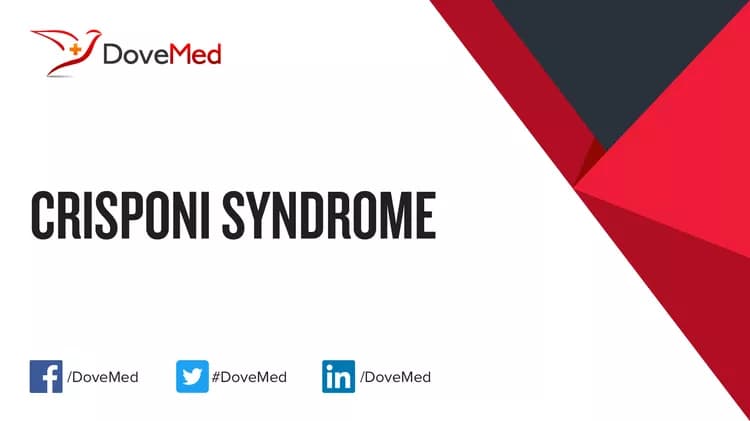What are the other Names for this Condition? (Also known as/Synonyms)
- CS (Crisponi Syndrome)
- Muscle Contractions, Tetanoform, with Characteristic Face, Camptodactyly, Hyperthermia, and Sudden Death
What is Crisponi Syndrome? (Definition/Background Information)
- Crisponi Syndrome (CS) is a severe disorder characterized by muscular contractions at birth, intermittent hyperthermia, facial abnormalities and camptodactyly
- Extensive paroxysmal muscular contractions in the face (resembling neonatal tetanus) develop after minimal stimuli. Frequent contractions of the oropharyngeal muscles associated with absence of the swallowing reflex lead to major feeding and respiratory difficulties
- All patients described to date displayed facial anomalies, including a large face, chubby cheeks, a broad nose with anteverted nostrils and long philtrum, and bilateral camptodactyly. Hypertonia is frequent
- Early in the neonatal period, CS patients develop continuous hyperthermia (unrelated to infectious agents), dyspnea, spells of apnea, and cyanosis during crying. Abnormal central control of respiration may be present at birth, increasing the risk of sudden death
- Febrile episodes disappear after the first year of life, whereas feeding difficulties persist. Paradoxal sweating after exposure to low ambient temperatures has been observed in some adolescents
- Crisponi Syndrome is transmitted as an autosomal recessive trait. CS belongs to a group of conditions with overlapping features, including cold-induced sweating syndromes and Stüve-Wiedemann syndrome
- Since the first description of the disease in 1996, it has been described in less than 30 patients from 13 Italian (mainly Sardinian) families
(Source: Crisponi Syndrome; Orphanet, National Institute of Health and Medical Research (INSERM), Paris.)
Who gets Crisponi Syndrome? (Age and Sex Distribution)
- Crisponi Syndrome is an extremely rare congenital disorder. The presentation of symptoms may occur at birth
- Both males and females may be affected
- Worldwide, individuals of all racial and ethnic groups may be affected
What are the Risk Factors for Crisponi Syndrome? (Predisposing Factors)
- A positive family history may be an important risk factor, since Crisponi Syndrome can be inherited
- Currently, no other risk factors have been clearly identified for CS
It is important to note that having a risk factor does not mean that one will get the condition. A risk factor increases one’s chances of getting a condition compared to an individual without the risk factors. Some risk factors are more important than others.
Also, not having a risk factor does not mean that an individual will not get the condition. It is always important to discuss the effect of risk factors with your healthcare provider.
What are the Causes of Crisponi Syndrome? (Etiology)
- Crisponi Syndrome is transmitted as an autosomal recessive trait. Mutations in the CRLF1 gene are causative
- CS belongs to a group of conditions with overlapping features, including cold-induced sweating syndromes and Stüve-Wiedemann syndrome
(Source: Crisponi Syndrome; Orphanet, National Institute of Health and Medical Research (INSERM), Paris.)
What are the Signs and Symptoms of Crisponi Syndrome?
The signs and symptoms of Crisponi Syndrome may include:
Very frequently present symptoms in 80-99% of the cases:
- Anteverted nares
- Camptodactyly of finger
- Feeding difficulties
- Full cheeks
- Hyperhidrosis
- Hypertonia
- Hypohidrosis
- Kyphosis
- Large face
- Long philtrum
- Malignant hyperthermia
- Respiratory insufficiency
- Scoliosis
- Wide nose
Frequently present symptoms in 30-79% of the cases:
- Cognitive impairment
- High palate
- Limitation of joint mobility
Occasionally present symptoms in 5-29% of the cases:
- Micrognathia
- Narrow mouth
- Seizures
(Source: Crisponi Syndrome; Genetic and Rare Diseases Information Center (GARD) of National Center for Advancing Translational Sciences (NCATS), USA.)
How is Crisponi Syndrome Diagnosed?
Crisponi Syndrome is diagnosed on the basis of the following information:
- Complete physical examination
- Thorough medical history evaluation
- Assessment of signs and symptoms
- Laboratory tests
- Imaging studies
- Biopsy studies, if necessary
Many clinical conditions may have similar signs and symptoms. Your healthcare provider may perform additional tests to rule out other clinical conditions to arrive at a definitive diagnosis.
What are the possible Complications of Crisponi Syndrome?
The complications of Crisponi Syndrome may include:
- Walking difficulties due to curvature of spine
- Sudden cardiac death
- Death in infancy is known to occur
Complications may occur with or without treatment, and in some cases, due to treatment also.
How is Crisponi Syndrome Treated?
- Surviving patients usually develop severe progressive kyphoscoliosis that requires corset therapy or corrective surgery
- Marked feeding difficulties require nasogastric tube feeding
(Source: Crisponi Syndrome; Orphanet, National Institute of Health and Medical Research (INSERM), Paris.)
How can Crisponi Syndrome be Prevented?
Currently, Crisponi Syndrome may not be preventable, since it is a genetic disorder.
- Genetic testing of the expecting parents (and related family members) and prenatal diagnosis (molecular testing of the fetus during pregnancy) may help in understanding the risks better during pregnancy
- If there is a family history of the condition, then genetic counseling will help assess risks, before planning for a child
- Active research is currently being performed to explore the possibilities for treatment and prevention of inherited and acquired genetic disorders
Regular medical screening at periodic intervals with tests and physical examinations are recommended.
What is the Prognosis of Crisponi Syndrome? (Outcomes/Resolutions)
- Characteristic hyperthermic crises frequently lead to death within the first months of life in individuals with Crisponi Syndrome
(Source: Crisponi Syndrome; Orphanet, National Institute of Health and Medical Research (INSERM), Paris.)
Additional and Relevant Useful Information for Crisponi Syndrome:
The following DoveMed website link is a useful resource for additional information:
Related Articles
Test Your Knowledge
Asked by users
Related Centers
Related Specialties
Related Physicians
Related Procedures
Related Resources
Join DoveHubs
and connect with fellow professionals


0 Comments
Please log in to post a comment.